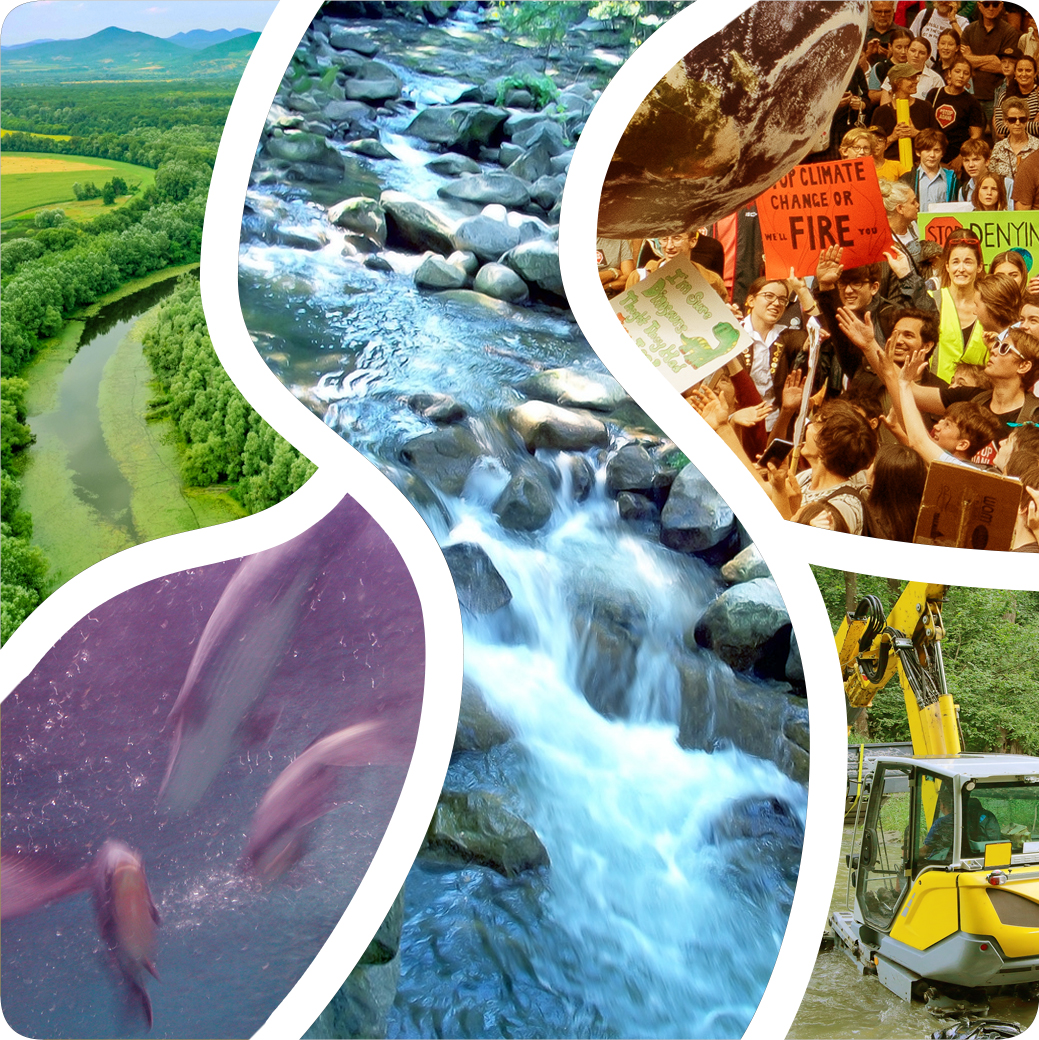Dr Frankie Thielen
Director / Dr. rer. Nat. Biology, Fondation Hëllef fir d’Natur
NGOs & Civil Society

My Projects
- Key project facts
Our NGO was leading three LIFE Nature projects to improve and restore riverine freshwater habitats. I was especially involved in two projects on protecting 2 highly endangered freshwater mussels. Furthermore, our NGO purchases land, particularly along waterways and is actively creating small wetlands (e.g. ponds) to enhance biodiversity. We also carry out watercourse restoration on our land and help to implement these measures.
- What impact did these projects have on biodiversity, if any?
Only due to the LIFE Freshwater Pearl Mussel Project, some animals from the local population are still around and able to help build up a new population. Through targeted breeding and release of the animals, the thick shelled river mussel population in Luxembourg has risen again.
The removal of migration barriers in smaller streams made these streams again accessible for brown trout to use them as spawning grounds. In many cases, the land we have purchased is now populated by European beavers. They renature the land independently and completely free of charge.
- What work challenges did you face and what approach did you take to solve them?
Implementing larger measures, such as LIFE projects, is costly and time-consuming. All stakeholders active in the area must and should be involved. The success of well-implemented measures is often quickly visible. However, successes that have already been achieved are often partially negated by intensification elsewhere in the catchment area.
The commitment to clean aquatic habitats with all their ecosystem services is a never-ending process that must be continued in the future.
- What lessons learned are transferable to other places/projects?
E.g.: Part of the LIFE projects for the conservation of endangered freshwater mussels involved breeding the animals and reintroducing them into the wild. The methods used for this have been developed and optimised over the years and have already been passed on too many environmentalists throughout Europe in training schools and workshops.
What is your biggest barrier and what are you trying to do about it?
I believe that the biggest problem is ensuring that the measures that have been successfully implemented are also secured for the future, so that they are not undermined by intensification measures elsewhere in the catchment area. This requires constant dialogue with all relevant stakeholders.
My Focus and Approach
- Lessons Learnt - Some recommendations for others?
- What’s most important:
To have staying power and be resistant to frustration.
- Do this, not that:
Communicate with everyone about the necessity of the projects. Do not make decisions over the heads of those affected.
- Always start by:
A well-thought-out project and concept that can be realised with the resources provided and within the time frame.
- What to do when things get difficult…:
Think flexibly and adapt the project to the new conditions if necessary.
- 5 simple steps to:
- Think about it
- What is realistically possible
- Where can I get the money
- Who will implement it
- Let's do it
- The biggest barrier and what I am trying to do about it:
Convince the population and all stakeholders that the projects and funds are necessary and will bring long-term added value to everyone. This can significantly increase the acceptance required for implementing projects.
- What’s most important:
My Journey
- My journey:
Being always fascinated by animals, plants and life itself, I decided to study biology and quickly detected my love for everything related to freshwater biology and ecology. After finishing my doctorate on freshwater fish parasitology and a research stay at the university Duisburg-Essen I got the opportunity to work for the NGO Fondation Hëllef fir d’Natur in the field of freshwater ecology and freshwater mussel protection. As most freshwater mussels use a fish species as a host to reproduce, this position really offered everything from my field of interest. Therefore, I did not hesitate at all to say yes. Meanwhile I work almost for 20 years in this field
- My Education:
- Biology with a focus on aquatic ecology University of Karlsruhe -Germany
- Doctorate in fish parasitology / University of Karlsruhe – Germany
- The Big Change:
Almost 20 years ago, we started breeding highly endangered freshwater mussels with modest means to prevent local populations from becoming extinct. Exchanging ideas with colleagues from abroad has helped us make steady progress. Our breeding station is now known throughout Europe and beyond, and we have passed on our knowledge to many other environmentalists. This has led to the breeding of endangered freshwater mussel species throughout Europe. However, the most important aspect in my work is and remains the preservation and renaturation of our freshwater habitats. Without them, even the bred animals cannot survive in the long term.
- Favourite part of the work I do:
Being in nature itself and seeing the condition of our waters live during monitoring. Passing on the necessity of freshwater protection to future generations.
Interview
Key Topics:
Key Topics
These relate to specific topics (e.g. technical solutions; restoration activities etc.) addressed within the showcase materials.
- River restoration
- Freshwater mussel protection & monitoring
- Freshwater mussel propagation
- Enhance and protect freshwater biodiversity
Prone2Success Factors Demonstrated:
Prone2Success Factors Demonstrated
These are the Prone2Success checklist factors which are highlighted within this showcase. More information on the Prone2Success checklist can be found here.
- Supports WFD, NRL and other restoration policy goals
- Communicate/engage with stakeholders from the outset
- Engage with the local community from the outset
- Obtain sufficient finance for all project stages
- Local planning processes are transparent / clearly understood
- Include long term monitoring
- Ensure stakeholder understanding / education of restoration goals & benefits
- Demonstrate specific ecological improvements/legal compliance / communicating results during and after the project
NRL Restoration Categories:
NRL Restoration Categories
These are the restoration categories (listed under Annex VII of the European Nature Restoration Law (NRL) which are relevant to this showcase.
- [2] Improve hydrological conditions
- [5] Re-establish river meandering
- [6] Remove obsolete barriers
- [7] Re-naturalise river beds
- [2] Improve hydrological conditions
- [5] Re-establish river meandering
- [6] Remove obsolete barriers
- [7] Re-naturalise river beds
Was this information useful?
No
Thank you for submitting feedback.
Click here to share your thoughts
Resources
Articles
- Buckets of muckets: A compact system for rearing juvenile freshwater mussels
DOI: 10.1016/j.aquaculture.2005.08.028
This article showed me that freshwater mussel culture for conservation issues takes also place in the US and helped us to contact the people from the US. This helped us a lot in our efforts to improve the rearing methods for our endangered species - Strategies for the conservation of endangered freshwater pearl mussels (Margaritifera margaritifera L.): a synthesis of Conservation Genetics and Ecology
DOI: 10.1007/s10750-010-0190-2
This article showed the importance of FPM on ecosystems and that action should be taken now.
Videos
Die Bachmuschel, unbekannt, nützlich, bedroht
LIFE Unio, Unio crassus release Our/ Sauer 2018
40 ans – 40 réserves – Kalbermillen
Thielen et al FMCS Virtual 2021 Guided tour Kalbermillen Lux
Peer reviewed papers
- Captive breeding of European freshwater mussels as a conservation tool: A review
September 2023
Aquatic Conservation Marine and Freshwater Ecosystems
DOI: 10.1002/aqc.4018 - A roadmap for the conservation of freshwater mussels in Europe
October 2022
Conservation Biology 37(2)
DOI: 10.1111/cobi.13994 - Influence of the excystment time on the breeding success of juvenile freshwater pearl mussels (Margaritifera margaritifera)
June 2014
Aquatic Conservation Marine and Freshwater Ecosystems 25(1)
DOI: 10.1002/aqc.2471 - The first millimetre – rearing juvenile freshwater pearl mussels (Margaritifera margaritifera L.) in plastic boxes
December 2013
Aquatic Conservation Marine and Freshwater Ecosystems 23(6)
DOI: 10.1002/aqc.2384
Clippings, white papers
- European Freshwater Bivalves: moving from assessment to conservation planning
June 2025
Publisher: IUCN
Acknowledgements & Links
This material was provided by: Frankie Thielen
Funding by:
- LIFE Nature Project funding
- LIFE05 NAT/L/000116: Ardmouperl - Restoration of pearl mussel populations in the Ardennes
- LIFE11 NAT/LU/000857: Resto-unio - Restoration of Unio crassus rivers in the luxemburgish Ardennes



